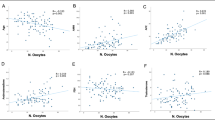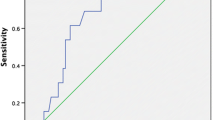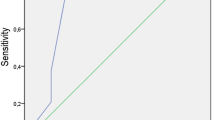Abstract
Background
In this prospective clinical single blind study, we aimed to investigate whether day 3 serum inhibin B levels in women with polycystic ovarian syndrome(PCOS) are of predictive value for the estimation of the ovarian response to gonadotropins.
Methods
Ovulation induction with low dose step-up gonadotropin protocol, starting with 75 IU/day, was performed for 30 cycles on 25 patients with PCOS. Day 3 serum inhibin B, follicle-stimulating hormone(FSH) and estradiol, and midluteal serum progesterone levels were measured during each cycle. The correlations between day 3 inhibin B levels and day 3 FSH, day 3 estradiol and midluteal progesterone measurements, as well as the amount of gonadotropin required to provide an ovulatory cycle were investigated.
Results
Five (27.8%) out of 18 cycles with day 3 inhibin levels <50.0 pg/ml; and 11 (91.7%) out of 12 cycles with levels ≥ 50.0 pg/ml were ovulatory (χ2=9.38, p<0.01). Moreover, day 3 inhibin B levels had statistically significant negative correlation with the gonadotropin used; and significant positive correlation with the midluteal progesterone levels (p<0.05). There wasn't any significant relation between day 3 FSH and estradiol levels with the gonadotropin used and progesterone levels.
Conclusions
It has been observed that as day 3 serum inhibin B levels increased in women with PCOS, the ovulatory response to gonadotropins and the rate of ovulatory cycles increased significantly.
Similar content being viewed by others
References
Anderson RA, Groome NP, Baird DT (1998) Inhibin A and inhibin B in women with polycystic ovarian syndrome during treatment with FSH to induce mono-ovulation. Clin Endocrinol 48(5):577–584
Balasch J, Creus M, Fabregues F, Carmona F, Casamitjana R, Ascaso C, Vanrell JA (1996) Inhibin, follicle-stimulating hormone, and age as predictors of ovarian response in in vitro fertilization cycles stimulated with gonadotropin-releasing hormone agonist-gonadotropin treatment. Am J Obstet Gynecol 175(5):1226–1230
Buckler HM, Robertson WR, Sun JG, Morris ID (1992) Immunoreactive inhibin levels during ovarian stimulation may predict granulosa cell maturity. Clin Endocrinol 37:552–557
Danforth DR (1995) Endocrine and paracrine control of oocyte development. Am J Obstet Gynecol 172:747–752
Eldar-Geva T, Robertson DM, Cahir N, Groome N, Gabbe MP, Maclachlan V, Healy DL (2000) Relationship between serum inhibin a and b and ovarian follicle development after a daily fixed dose administration of recombinant follicle-stimulating hormone. J Clin Endocrinol Metab 85:607–613
Elting MW, Korsen TJM, Rekers-Mombarg LTM, Schoemaker J (2000) Women with polycystic ovarian syndome gain regular menstrual cycles when ageing. Hum Reprod 15:24–28
Elting MW, Kwee J, Schats R, Rekers-Mombarg LT, Schoemaker J (2001) The rise of estradiol and inhibin B after acute stimulation with follicle-stimulating hormone predict the follicle cohort size in women with polycystic ovary syndrome, regularly menstruating women with polycystic ovaries, and regularly menstruating women with normal ovaries. J Clin Endocrinol Metab 86(4):158915–95
Erickson GF, Danforth DR (1995) Ovarian control of follicle development. Am J Obstet Gynecol 172:736–747
Gill S, Taylor AE, Martin KA, Welt CK, Adams JM, Hall JE (2001) Spesific factors predict the response to pulsatile gonadotropin-releasing hormone therapy in polycystic ovarian syndrome. J Clin Endocrinol Metab 86:2428–2436
Gökyar D, Kökçü A, Yanik F, Cetinkaya MB, Alper T, Malatyalioglu E (2001) Basal and day 12 inhibin concentrations in the prediction of ovarian response to gonadotrophins in women with PCOS. Hum Reprod 16(10):2079–2083
Groome NP, Illingworth PJ, O'Brien M, et al (1996) Measurement of dimereic inhibin B throughout the human menstrual cycle. J Clin Endocrinol Metab 81:1401–1405
Hayes FJ, Hall JE, Boepple PA, Crowley WF (1998) Differential control of gonadotropin secretion in the human: Endocrine role of inhibin. J Clin Endocrinol Metab 83(6):1835–1841
Hershlag A, Peterson CM (2002) Endocrine disorders. In: Berek JS (ed) Novak's gynecology. Lippincott Williams and Wilkins, Philadelphia, pp 871–930
Imani B, Eijkemans MJ, de Jong FH, et al (2000) Free androgen index and leptin are the most prominent endocrine predictors of ovarian response during clomiphene citrate induction of ovulation in normogonadotropic oligoamenorrheic infertility. J Clin Endocrinol Metab 85:676–682
Klein NA, Illingworth PJ, Groome NP, et al (1996) Decreased inhibin secretion is associated with the monotrophic FSH rise in older ovulatory women. J Clin Endocrinol Metab 81:2742–2745
Lambert-Messerlian G, Taylor A, Leykin L, et al (1997) Characterization of intrafollicular steroid hormones, inhibin, and follistatin in women with and without polycystic ovarian syndrome following gonadotropin hyperstimulation. Biol Reprod 57:1211–1216
Laven JS, Imani B, Eijkemans MJ, de Jong FH, Fauser BC (2001) Absent biologically relevant associations between serum inhibin B concentrations and characteristics of polycystic ovary syndrome in normogonadotrophic anovulatory infertility. Hum Reprod 16(7):1359–1364
Licciardi FL, Liu HC, Rosenwarks Z (1995) Day 3 oestradiol serum concentration as prognostic data of ovarian stimulation response and pregnancy outcome in patients undergoing in vitro fertilization. Fertil Steril 64:991–994
Lockwood GM, Muttukrishna S, Groome NP, Matthews DR, Ledger WL (1998) Mid-follicular phase pulses of inhibin B are absent in polycystic ovarian syndrome and are initiated by successful laparoscopic ovarian diathermy: a possible mechanism regulating emergence of the dominant follicle. J Clin Endocrinol Metab 83(5):1730–1735
Magoffin DA, Jakimiuk AJ (1998) Inhibin A, inhibin B and activin A concentrations in follicular fluid from women with polycystic ovary syndrome. Hum Reprod 13(1O):2693–2698
Matson PL, Morris ID, Sun JG, Ibraham ZHZ, Lieberman BA (1991) Serum inhibin as an index of ovarian function in women undergoing pituitary down-regulation and ovarian stimulation in an in-vitro fertilisation program. Horm Res 35:173–177
McLachlan RI, Robertson DM, Healy DL, de Kretser DM, Burger HG (1986) Plasma inhibin levels during gonadotropin induced ovarian hyperstimulation for IVF: A new index of follicular function. Lancet 1:1233–1234
Norman RJ, Milner CR, Groome NP, Robertson DM (2001) Circulating follistatin concentrations are higher and activin concentrations are lower in polycystic ovarian syndrome. Hum Reprod 16(4):668–672
Pellicer A, Mari M, de los Santos MJ, Simon C, Remohi J, Tarin JJ (1994) Effects of aging on the human ovary: the secretion of immunoreactive a-inhibin and progesterone. Fertil Steril 61:663–668
Pigny P, Cortet-Rudelli C, Decanter C, Deroubaix D, Soudan B, Duhamel A, Dewailly D (2000) Serum levels of inhibins are differentially altered in patients with polycystic ovary syndrome: effects of being overweight and relevance to hyperandrogenism. Fertil Steril 73(5):972–977
Scott RT Jr, Hofmann GE (1995) Prognostic assessment of ovarian reserve. Fertil Steril 63:1–11
Seifer DB, Charland C, Berlinsky D, Penzias AS, Haning RV Jr , Naftolin F, Barker BE (1993) Proliferative index of human luteinized granulosa cells varies as a function of ovarian reserve. Am J Obstet Gynecol 169:1531–1535
Seifer DB, Gardiner AC, Lambert-Messerlian G, Schneyer AL (1996) Differential secretion of dimeric inhibin in cultured luteinized granulosa cells as a function of ovarian reserve. J Clin Endocrinol Metab 81(2):736–739
Seifer DB, Lambert-Messerlian G, Hogan JW, Gardiner AC, Blazer AS, Berk CA (1997) Day 3 serum inhibin-B is predictive of assisted reproductive technologies outcome. Fertil Steril 67(1):11–15
Van der Meer M, Hompes PGA, De Boer JAM, Schats R, Schoemaker J (1998) Cohort size rather than FSH threshold level determines ovarian sensitivity in polycystic ovary syndrome. J Clin Endocrinol Metab 83:423–426
Welt CK, Schneyer AL (2001) Differential regulation of inhibin B and inhibin a by follicle-stimulating hormone and local growth factors in human granulosa cells from small antral follicles. J Clin Endocrinol Metab 86(1):330–336
Author information
Authors and Affiliations
Corresponding author
Rights and permissions
About this article
Cite this article
Kökçü, A., Turhan, E., Çetinkaya, M.B. et al. Inhibin B levels on cycle day 3 to predict the ovulatory response in women with PCOS undergoing ovulation induction via low dose step-up gonadotropin protocol. Arch Gynecol Obstet 270, 255–259 (2004). https://doi.org/10.1007/s00404-003-0557-y
Received:
Accepted:
Published:
Issue Date:
DOI: https://doi.org/10.1007/s00404-003-0557-y




